<img src='http://www.halfmoonbaymemories.com/wp-content/thumb-DSCN0237.JPG' alt=<img src='http://www.halfmoonbaymemories.com/wp-content/thumb-DSCN0238.JPG' alt
Looks like this one is for a Coastside Brunhilde!

Created by June Morrall
<img src='http://www.halfmoonbaymemories.com/wp-content/thumb-DSCN0237.JPG' alt=<img src='http://www.halfmoonbaymemories.com/wp-content/thumb-DSCN0238.JPG' alt
Looks like this one is for a Coastside Brunhilde!
About the time of this interview with Pete Douglas, he celebrated his 50th with musician Benny Barth. Here is the invite.
This is Pete, I apologize for the poor condition of the photo I took. 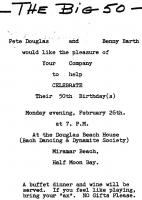
June: What do you think about wrinkles on women?
Pete: Wrinkles on women? If they’re not excessive for their age, I don’t find them unattractive. If they’re in good physical shape overall, that more than compensates for a few wrinkles. I find most women with a few smile lines, eye wrinkles in the corner, minimal, hardly distracting.
June: Should women stay out of the sun?
Pete: No question about it. Excessive sun wreaks havoc on the face.
June: Here at the Bach (Dancing & Dynamite Society), you see women of all ages. What have you heard?
Pete: From women in their 30s, I hear references to getting older. They might mention a few wrinkles and gray in their hair. They don’t belabor the point, just small references. In the face in the 40s, wrinkles become much more pronounced, but has more to do with personality shining through–and keeping themselves in good shape. Not letting themselves get overweight. I’ve seen dynamite looking women in their 50s–(laughter)they’re all going out with younger guys.
June: And the very young women?
Pete: The young, fresh thing is like a picture postcard but it kind of idealizes things–you got to be the best for your age. At 22 it’s a pure fantasy thing for a lot of men–but if you’re looking for a real person who has developed a real personality, women who are older are more interesting.
June: What about men and wrinkles?
Pete: Men just worry about getting bald–they don’t worry about a few wrinkles over 30. You see a cigarette ad and it’s fine to see a macho western man with a craggy face–you never see a woman that way. The only time a man gets bothered by wrinkl.es is just by getting older. That, and other signs, his getting older and his powers and abilities and general demeanor at being effective might be diminished. Obviously a lot of middle-aged executives go to a lot of trouble looking younger, getting face lifts.
Let me explain: A long time ago I decided to do a story about wrinkles, you know, about how obsessed women are with them and the lengths they will go to eliminate them–that was the idea– but my story was going to have a lot of humor. My story was going to be very funny.
Wrinkles are funny, right?
I took the idea to the San Jose Mercury News’ magazine–which was very hot at the time. The editor and his magazine were widely admired, and I convinced the editor to let me write this “laugh your head off” article about wrinkles for his great magazine.
I worked hard on the piece–I wanted it to be everything I promised it would be–there was the well known San Mateo County dermatologist who told me women should stick Scotch tape on their faces in order to prevent laugh lines and crows feet from developing. Stunt them before they grow– especially when talking on the phone, he said, women should wear Scotch tape in strategic places.
I interviewed a Berkeley author who had just published a book about my subject and then died in a freak car accident soon after. Besides the usual advertising promises from the cosmetic industry, I collected unusual and ancient rememdies for wrinkles like special, smooth rocks encased in what looked like a lovely jewelry box.
I also interviewed a couple of Coastsiders, one of them was Pete Douglas, the famous Miramarian ( one who lives in Miramar) and runs the world class jazz house, Bach Dancing & Dynamite Society. Anyone who knows Douglas knows he is opinionated, has a wry sense of humor–and most importantly for me, who was writing a humorous story about wrinkles, Pete has a craggy face. I thought: this man knows facial lines and from his vantage point at the Bach he is a great observer of life.
But the interview with Pete turned out to be far more serious than I ever thought he’d be. Very understanding and sympathetic.
To the bitter end, I believed my wrinkles piece was hilarious and didn’t get the hint that things were going badly–even when I read excerpts to my friends and didn’t get laughs. Not one. The truth was, the story flopped, and in the end, the magazine gave me a “kill fee” for it. They paid me to go away.
In the next post, I’ll write-up the interview with Pete.
—–
okay, I have finally found my story called “Wrinkles,” the piece I sent to the San Jose Mercury News magazine when it was hot, and that would be in the mid-1980s.Of course, what I wrote did not jive with what the magazine wanted. I was paid a non-run fee, which I didn’t event want. I mean, if my work isn’t good enough, should I take a fee for it, anyway? It wasn’t my style; I still feel guilty about it.
Actually, I now see that this is not the article but a treatment for a documentary type show. At one time that was a dream but it died. So here is the treatment for “Wrinkles.” I know it’s crummy, but it is what it is.
Introduction
Wrinkles
The wrinkle is being attacked. By whom? The baby boomers facing wrinklehood. Everywhere there’s talk and concern. And psychological fallout, especially among women, the primary target of the billion dollar beauty industry.
Wrinkles make a man look distinguished while women just age.
“…You all know that gray hair and wrinkles give a man authority, dignity and importance and give a woman reason to rush out for hair dye and a face lift….” said “keynote” speaker Geraldine Ferraro at the 1983 New York State Convention on Midlife and Older Women.
But wrinkles affect everyone. Even movie stars get wrinkles; even men get eye tucks.
The overall reaction is how to get rid of, minimize, or disguise wrinkles. So, bottle after bottle, jar after jar of anti-wrinkle potions line cosmetic counters. Their names run from the exotic to clinical….Sperm Whale Oil, Zyderm Collagen, Bilberry Juice, Goodbye Wrinkles, and Formula 405.
Collagen injections, laser treatments, face lifts and acupuncture are the heavy laser treatments. New prescription topical medicines such as Efudex and Retin-A promise to resurface or “grow new skin” –although there’s the price of discomfort to pay. Books tell how to eliminate wrinkles with special facial massages–and even hot spoons to iron out wrinkles. (Ouch). And if all else fails, psychiatrist can held clients cope with the inevitable.
But there’s another side to this story. And, that is, up-lifting the wrinkle’s bad reputation through their beauty, and the forgotten art of face reading which determines a person’s fate from facial lines.
“Wrinkles” is a 30=minute show, which shows all sides of the lowly wrinkle–the lotions and revolutionary treatments, the fears and the humor of living in a wrinkle-less society.
Wrinkles: The Treatment
[I don’t know what they do today; but in the 1980s a writer had to submit what was called a treatment, which was the visual way the show would be filmed. Does that make sense? I tried but it’s a tough business and I couldn’t get it right.]
We open with an extreme close-up shot of wrinkles. They look like a tributary of rivers or cracks in a parched desert. The narrator advices viewers that what they’re seeing is not what it seems to be. Maybe it’s the Brazilian jungle, maybe it’s the ancient seas…maybe….
Pulling back, we see a man in his 40s staring in the mirror at his face. He’s closely examining his wrinkles, one by one. He talks about the history of each line. Some stories are funny; some sad. He talks about a broken heart, a job as a lifeguard and a dangerous expedition he went on into the Himalayas.
Fade into a shot of a woman looking at her wrinkles in the mirror. She,too, has stories for each line. The baby, the problems at work, divorce, and being left without funds to support herself and child.
Wrinkles have lives of their own. Their own stories.
We move to shots of crowds of people with wrinkles: every conceivable shape a wrinkle can take, radiating from the eyes, baby lines, and older ones that follow their own trails. The narrator is being pro-wrinkle, showing us beautiful and artistic lines.
Charlie Nye’s father, also called Charlie Nye, saw opportunity when his neighbors gave up after the Ocean Shore Railroad showed signs of faltering.
The 1906 earthquake, with its epicenter at nearby Mussel Rock, struck a mighty blow at the work the Ocean Shore was doing near Devil’s Slide. After having read personal horrifying accounts of the earth moving in downtown San Francisco, I can only imagine the shaking at the Slide.
In the 1880s Mr. Wienke, whose wife,Meta, was distantly related to the sugar king Claus Spreckels, established a beach resort at Moss Beach. Getting people to come was hampered because Wienke’s hotel was isolated and the carriage ride a long, dusty, uncomfortable one. The railroad, which planned an iron road from San Francisco to Santa Cruz, promised to deliver untold number of tourists–and now nature had reduced all that to temporary rubble as the Ocean Shore people cleaned up and took financial nventory.
I guess the railroad was committed to see their project through to the bitter end and they plowed ahead–even coming up with a couple of little gas powered coaches, much, much cleaner burning than the billows of black dirty smoke emitting from the coal-powered engines as they choo choo-ed across the Coastside landscape.
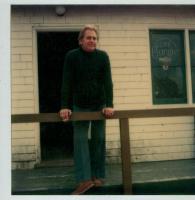 “My father had a chance to acquire ‘The Reefs’ which was built by Wienke,” Charlie Nye, Jr. explained.
“My father had a chance to acquire ‘The Reefs’ which was built by Wienke,” Charlie Nye, Jr. explained.
That was exciting for what the Reefs had been built right on the sandy beach of the present day Fitzgerald Marine Reserve. There was no foundation as the building stood on 16-foot stilts.
Charlie Nye: When the Reefs was first built it was built on the sand and there were rows of bathhouses on one side and a dance floor on the other side where they used to have an orchestra. There was a road to the beach and people used to drive down with their horse and buggies. There was a chute we used to sllide groceries down from the cliff to the beach.”
A romantic place like this instantly drew the famous of the time, the botanist Luther Burbank, breeder of plums and prunes, and many other plant varieities, and the great writer Jack London, who loved the sounds of the sea and whose adventurious sea stories were read by every male child.
Guests fished, boated and hunted abalone.
On the day the Reefs officially passed from Mr. Wienke to Charlie Nye, the new owner faceda smelly problem.
Charlie Nye (deadpan): A dead whale had washed ashore–and it was highly potent. They tried everything they could think of to get rid of the carcass. Finally they blew it up with dynamite and there was just more whale over everything.
It was either Charlie’s father or Mr. Wienke who had done the interior decorating at The Reefs, using only what could be found locally. Every inch of wall, from floor to ceiling, was covered with silvery blue abalone shells. The abalone chowder was a big hit and in later years Charlie Nye’s father revealed the secret to his delicous recipe: mince the abalone in a sausage grinder.
Two views of the new de Young Museum in Golden Gate Park by my artist friend and landscaper Leon Kunke. Looks llike an upside down copper pyramid.
By the way Golden Gate Park looks the best it’s looked in a very long time. The waterfalls are gushing and they’ve done fresh planting everywhere, all around the park. Impressive. The de Young’s new look, however, remains controversial. I love it!
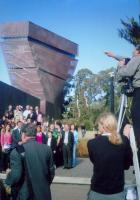

(Photo: A view of the drive-in part of Alves Dairy: 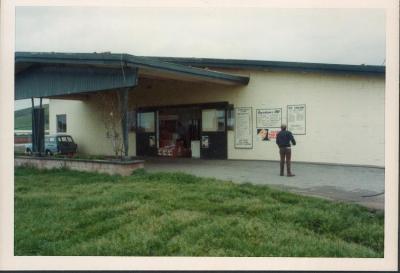 )
)
In February 1978 Alves Dairy sold its last bottle of delicious chocolate milk. I interviewed owner Ernie Alves a few days before the famous south of Half Moon Bay dairy closed down forever. We stood outside the 1950s-style drive-in dairy and talked about the history of the Alves family and the dairy.
Part II
Ernie Alves struck me as a guy who knew everything about farming so I was amazed when he confessed, “As far as cows go, strange as it sounds, I have never milked a cow until a month ago. I’ve always been in processing. I had to give our milker a day off, so my wife, my daughter and I milked the cows. I guess we’ve done it about three times now.”
1977-78 had been a rough year for the Alves family. His brother Frank was driving the dairy’s van back from Pescadero when he was involved in an accident. Frank’s injuries included a twisted neck and broken back.
Ernie: It took three men to replace Frank. This last year has been one madhouse as far as I’m concerned.
That was one of the reasons the Alves family decided to close the dairy, lease the land and sell the cows.
Ernie’s ancestors immigrated from the Azore Islands, settling in Pescadero in the 1800s. The family produced cheese at the rustic Willowside Ranch on a stretch of scenic Stage Road marked by a grove of mammoth eucalyptus trees.
(Is this the colorful Willowside Ranch? 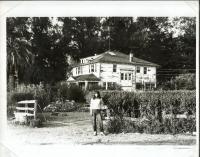 photo by Suzanne Meek)
photo by Suzanne Meek)
Ernie: My father told me that when he drove the cheese by wagon from Pescadero to Watsonville, they had to time it. By the time they got to Waddell Bluff, it had to be low tide or else there would be no beach.
The Alves family moved operations north to Half Moon Bay in the 1890s.
Ernie: My father knew it was noon when the stagecoach rumbled by–he was plowing the fields then.
About 1923 Ernie’s father gave up cheesemaking and purchased a lovely Victorian house on Kelly Avenue in Half Moon Bay.
(Photo: In the 1970s M/M Alves stand in front of their Victorian house on Kelly Ave, formerly known as the “Ben Cunha” house .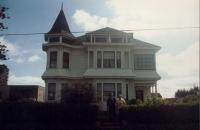
Ernie: Then we took one cow and somebody wanted milk. Pretty soon we had two cows, then three cows. When they got too large for back of the house, the cows were moved down to where the Little League fields are.
A decade later a barn was built with a room to bottle raw milk.
Ernie (a student at the time): We had a walk-in box and the whole bit.
Ten more years raced by and a bigger barn was built. The Alves converted a building near the Victorian house into a processing plant. The milk was carried in 10-gallon cans from the ranch (the Little League fields) to the plant.
Ernie: The way I remember that the plant was built in 1941 is that we had two bricklayers, and it was December of ’41 when we started it. The war had begun. Highway 1 wasnot here as you see it now: Main Street was Highway 1.